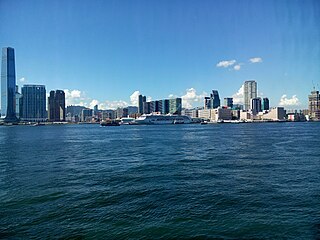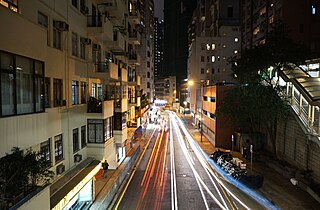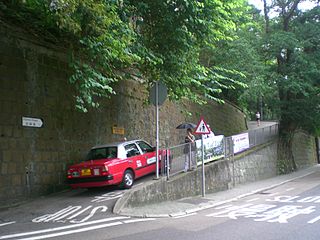
Hong Kong Island is an island in the southern part of Hong Kong. Known colloquially and on road signs simply as Hong Kong, the island had a population of 1,289,500 and a population density of 16,390 per square kilometre (42,400/sq mi), as of 2008. The island had a population of about 3,000 inhabitants scattered in a dozen fishing villages when it was occupied by the United Kingdom in the First Opium War (1839–1842). In 1842, the island was formally ceded in perpetuity to the UK under the Treaty of Nanking and the City of Victoria was then established on the island by the British Force in honour of Queen Victoria. The Central area on the island is the historical, political and economic centre of Hong Kong. The northern coast of the island forms the southern shore of the Victoria Harbour, which is largely responsible for the development of Hong Kong due to its deep waters favoured by large trade ships.

Kowloon is an urban area in Hong Kong comprising the Kowloon Peninsula and New Kowloon. With a population of 2,019,533 and a population density of 43,033/km2 (111,450/sq mi) in 2006, it is the most populous area in Hong Kong, compared with Hong Kong Island and the rest of the New Territories. The peninsula's area is about 47 km2 (18 sq mi).

Mid-Levels is an affluent residential area on Hong Kong Island in Hong Kong. It is located between Victoria Peak and Central. Residents are predominantly more affluent Hong Kong locals and expatriate professionals.

Lung Fu Shan Country Park, established 18 December 1998, is a country park in the Central and Western District of Hong Kong. It covers the densely vegetated slopes of Lung Fu Shan, and includes the disused Pinewood Battery as well as the Pinewood Garden picnic area, providing a scenic backdrop to the residential and commercial districts of Hong Kong Island.

Robinson Road is a thoroughfare located in Mid-Levels, Hong Kong Island, Hong Kong. To the east, it intersects with Magazine Gap Road and Garden Road, while to the west, it connects with Babington Path and Park Road.

Taikoo Shing or Tai Koo Shing, is a private residential development in Quarry Bay, in the eastern part of Hong Kong Island, Hong Kong. It is a part of Swire's property business, along with Taikoo Place, the adjacent Cityplaza retail and office complex and EAST, a lifestyle business hotel.

The Central Elevated Walkway is an extensive footbridge network spanning Admiralty, Central and parts of Sheung Wan, near Victoria Harbour in Hong Kong.

Braemar Hill is a hill with a height of 200 metres (660 ft) south of Braemar Point on Hong Kong Island, Hong Kong. The hill was likely named after the Scottish village of Braemar by British officials.
First Street is a street in Sai Ying Pun, an early suburb of Hong Kong.
Articles related to Hong Kong include:

Kotewall Road is a street in Mid-Levels, Hong Kong Island, Hong Kong, located between Po Shan Road and Robinson Road. It is a 400-metre-long two-way road located on hill slopes south of Sai Ying Pun.

Pound Lane is a lane in Sheung Wan on Hong Kong Island, Hong Kong.

The Central and Western District located on northwestern part of Hong Kong Island is one of the 18 administrative districts of Hong Kong. It had a population of 243,266 in 2016. The district has the most educated residents with the second highest income and the third lowest population due to its relatively small size.

Hatton Road, also known as "The Morning Trail", is a paved, steep, motor vehicle-free road in western Hong Kong Island, Hong Kong, on Lung Fu Shan. It is largely used as a fitness trail for walking, running, and cycling.
A series of major landslides occurred in Hong Kong in June 1972. Several apartment complexes and houses were wiped out, and at least 156 people lost their lives. The landslides had been caused by waterlogged soils in the area, a result of Typhoon Rose bringing unusually heavy rainfall in August 1971 as well as heavy rainstorms hitting Hong Kong on the days preceding the landslides.















